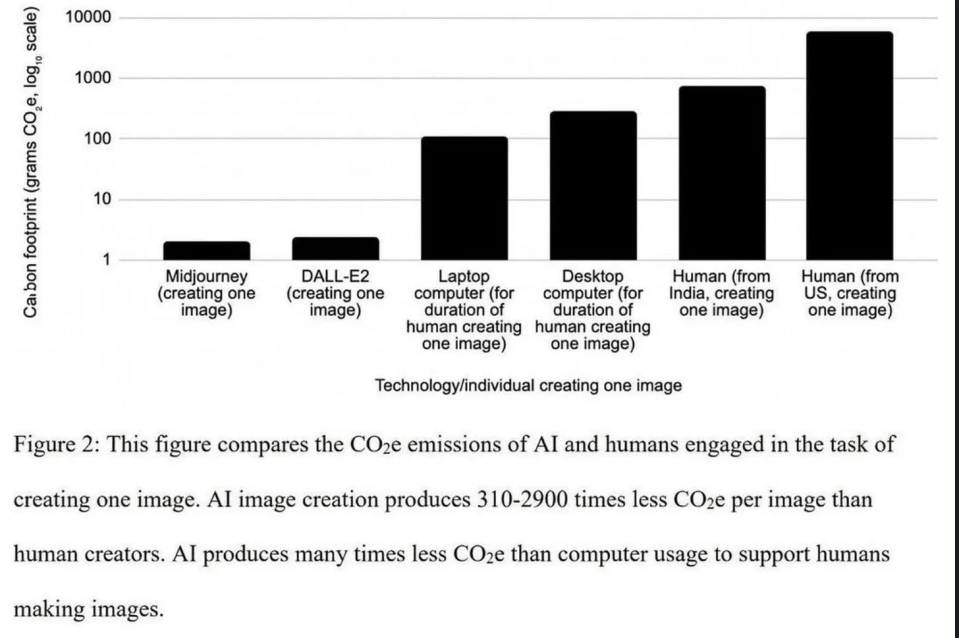Why am I searching for Regenerative Intelligence? Because we humans need help in going forward in a healthy, desirable direction. Two major forces will decide a big part of our fate; climate change and AI. And while I think humans are brilliant creative creatures, despite all our endearing weaknesses, I think we can use all the help we can find. I want to look for a synergy between the weaknesses and strengths of these three different kinds of intelligence.
Regenerative Intelligence is an ambitious goal, something to strive towards to. I’m shooting for the stars, while hopefully maintaining my Dutch down-to-earth attitude. Let’s see how this journey unfolds ;).
For now, let’s dive in; what are the most noteworthy developments in our quest for Regenerative Intelligence?
- AI Images: Unprecendented Realism and Increasing Energy Costs
- AI solving math problems and finding new materials
- AI companions bots
- The Regenerative Poop-Loop of Whales
1) AI Images: Unprecendented Realism and Increasing Energy Costs

Midjourney 6; Text in AI images and highly realistic
Midjourney 6 was released on December 21st, promising even more realistic AI-generated images than its predecessors.
From the reviews I’ve read so far, the response is overwhelmingly positive. V6 is noticeable better at generating text. To me personally the difference is getting harder to see, since the quality was quite good already. But please, take a look and decide for yourself.
I’ve created these images for you to compare.
Energy Costs
Research into the used energy to create such images is surging. Creating an image with AI costs about the same amount of energy as charging your smartphone. Having a human create a digital image is significantly more energy-intensive. See the visual below:

Degenerative or regenerative?
But what does this mean for the total energy used for all the created images? Now that we can instantly create images, will we do so more often? If so, how might this impact the total energy consumption for creating images? Could it double or even triple?
This brings to mind Jevons’s Paradox: increased efficiency often leads to increased usage. Consider cars: as engines became more efficient, we used that advantage to make vehicles larger and heavier (e.g., SUVs), resulting in almost no net gains in energy use per km. Resulting in almost no netto gains regarding energy use per km.
→ Technology on its own is never the answer regarding energy and climate problems. It’s always about how we use it. And, the more humans can do with AI, the wiser we need to act.
Read the full paper at: https://arxiv.org/abs/2303.06219
2) AI solving math problems and finding new materials

In the last month, we’ve seen two significant cases where AI complements human intelligence.
You might recognize the cards above from the card game Set, which has long inspired mathematicians. An AI named FunSearch, created by Google DeepMind and based on Large Language Models (LLMs), has made progress on one of these unsolved problems. “This is the first time anyone has shown that an LLM-based system can go beyond what was known by mathematicians and computer scientists,” says Pushmeet Kohli of Google DeepMind.
The involved researchers and mathematicians are astounded but not threatened by these advancements; they see AI as a “force multiplier” rather than a replacement for human mathematicians. They talk about “new modes of human–machine collaboration.”
—> Read more about it @ Nature.
380.000 New stable materials
Another AI tool, GNoME, also from Google, has discovered 2.2 million new crystals, offering immense hope for advancements in areas like renewable energy and advanced computation. While many of these crystals lack stability, the 381,000 most stable ones will be shared with scientists worldwide.
To put this in perspective: before this, humans had identified about 20,000 stable crystals. Computational methods later increased this to 48,000. GNoME’s discovery expands our knowledge to a staggering 421,000 stable materials. DeepMind compares this achievement to “800 years’ worth of knowledge.”
3) AI companions bots
The latest companion app, “Digi AI,” has gone viral on X, with tens of millions of views. While not the first of its kind, with predecessors like Replika and Character.AI, Digi AI seems to have struck a new chord. It’s available on both iOS and Android.
Consider the added complexity to parenting in an era already grappling with social media and game addiction. AI companion bots introduce an entirely new dimension. Their advanced voice recognition, combined with other recent technologies, enables convincingly Real Fake conversations. How should a parent deal with this? And lonely adults?
Some Pros and Cons:
👍🏻 AI companions provide emotional support and companionship, which is better than complete isolation.
👎🏻 However, they could potentially be a final destination for lonely teenagers, reducing their motivation to engage in real-life social interactions.
👍🏻👎🏻 Often marketed as a benefit, but actually a downside: The companion can be completely tailored to ones liking. –> This will create unrealistic expectations imo, and perpetuate gender stereotypes. And what happened with “accepting others as they are”?
AI companions are frequently marketed as a much-needed solution to loneliness. While this sounds appealing, I believe they might actually make it worse. It would be better in my opinion if the bot would bring people together. “Hi there, I see your neighbour is also lonely and open to invites. Shall I invite her on your behalf for a cup of tea this afternoon?”
Expect to see a lot of developments regarding AI friends / relations. In the end, only time will tell, but I predict that people will first mock AI companions, then slowly adopt them, and ultimately become addicted to them.
It’s parallel to the rise of cyber bullying, game addiction, social media and a negative self image. The difference could be that we have learned how to deal with those and use best practices (anyone)? My advice to parents and teachers is to at least experiment with these tools, take time to reflect on their impact, and, when appropriate, engage in open discussions about them.
4) The Regenerative Poop-Loop of Whales
So, that’s great. Better images which use even more energy, and AI doing some inventions and complementing our own intelligence. But it’s all about how we will use it. Will we exploit the earth further to find new base ingredients for these materials, or will we use this knowledge in a wiser, more regenerative way?
—> Let’s explore the regenerative role whales play in their environment. This story, encountered frequently during my research, is particularly inspiring and has been highlighted by George Monbiott (writer and zoologist) and Leen Gorissen (author of Natural Intelligence)
As you may know, whales are the largest mammals on our planet. The largest blue whale recorded in the Guinness Book of Records reaches a staggering 33.6 meters and weighs 190,000 kg. Despite, or perhaps because of, their immense size, these creatures remain powerful and beautiful mysteries. Their unique songs from the depths of the sea are said to be healing for heart and body aches, and their behavior, from playing with seaweed to protecting their calves, reveals a social intelligence. Whales call each other by name and even mention absent peers, suggesting they might gossip (!).
Time and again, we seem to misunderstand whales. A prime example occurred in the 1970s when it was believed that a decrease in whale populations would lead to an increase in fish and plankton, their food sources. The opposite proved true.
The idea was simple: without these warm-blooded giants, fish and plankton would no longer be consumed, and their numbers would increase. Economically, whaling was seen as a win-win situation and was pursued with ‘success.’ Within decades, this led to a critical point where whales neared extinction.
Surprisingly, the expected increase in fish and plankton populations did not occur. In fact, the opposite turned out to be true; in oceans where whales are protected and their numbers increase, there is a greater presence of plankton. It turns out that the plant part of plankton needs nutrients such as nitrogen and iron, which are abundant in whale feces. No feces, no plant plankton. No plant plankton, no animal plankton. And so it goes through the food chain.
And the list goes on and on. Besides the ‘poop-loop’, there’s also the ‘whale pump.’ When these marine mammals bring food from great depths and swim back to the surface to breathe, they mix water layers. This swimming behavior of whales is estimated to contribute to water mixing as much as the effects of wind, waves, and tides combined. Even in death, whales contribute to the climate. A large whale, when it dies, takes an average of 33 tons of CO2 to the deep-sea floor, removing tons of carbon from the atmosphere for centuries. Whales can rightly be called Ecosystem Engineers. They play an enormously important role in the regenerative nature of their own habitat. Compared to what we’ve mostly read until now, this turns the world upside down. The whale exhibits not degenerative (exploiting their environment) but regenerative behavior.
This can certainly be called smart and an key puzzle piece in our quest towards Regenerative Intelligence.

 English | EN
English | EN 
